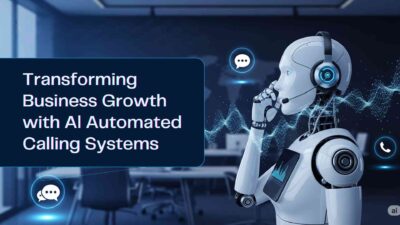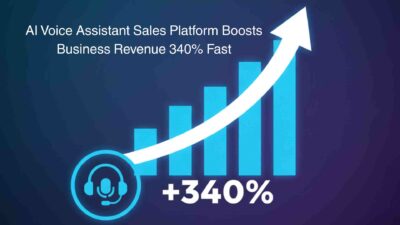TL;DR AI-powered customer acquisition represents a fundamental shift from traditional marketing methods to intelligent, data-driven strategies that identify, engage, and convert prospects with unprecedented precision and efficiency.
Table of Contents
Companies that fail to adopt conversational AI for sales strategies risk falling behind competitors who are already harnessing the power of machine learning, predictive analytics, and automated engagement systems to drive exponential growth. Personalized marketing with AI enables organizations to process vast amounts of data, identify hidden patterns, and execute targeted campaigns that resonate with specific audience segments while maximizing return on investment.
This comprehensive guide explores how businesses across industries are leveraging conversational AI for sales to achieve remarkable growth results. We’ll examine practical implementation strategies, explore proven techniques, and provide actionable insights that can help your organization harness the full potential of artificial intelligence to build a robust customer pipeline and sustain long-term business success.
Understanding AI-Powered Customer Acquisition Fundamentals
AI-powered customer acquisition encompasses a sophisticated ecosystem of technologies and methodologies designed to identify, attract, and convert potential customers through intelligent automation and data-driven insights. This approach combines machine learning algorithms, predictive analytics, natural language processing, and behavioral analysis to create highly effective customer acquisition systems.
The foundation of effective personalized marketing with AI rests on data collection and analysis capabilities that far exceed human capacity. These systems can process millions of data points simultaneously, identifying patterns and correlations that would be impossible to detect manually. By analyzing customer behavior, demographic information, purchase history, and engagement patterns, AI systems can predict which prospects are most likely to convert and determine the optimal approach for each individual.
Machine learning algorithms continuously improve Personalized marketing with AI performance by learning from each interaction and outcome. As the system processes more data and encounters various scenarios, it becomes increasingly accurate at predicting customer behavior and optimizing acquisition strategies. This self-improving capability ensures that client segmentation with AI systems become more effective over time.
Natural language processing capabilities enable AI systems to understand and respond to customer communications across multiple channels, from social media interactions to email inquiries and chat conversations. This understanding allows for personalized, relevant communications that build trust and guide prospects through the acquisition funnel more effectively.
Predictive analytics within automated customer onboarding systems can forecast client lifetime value, identify the most profitable market segments, and predict optimal timing for outreach efforts. These insights enable businesses to allocate resources more efficiently and focus on prospects with the highest probability of generating significant revenue.
Key Technologies Driving AI-Powered Customer Acquisition Success
The success of AI-powered customer acquisition depends on several interconnected technologies working together to create comprehensive client intelligence and engagement capabilities. Understanding these core technologies helps businesses make informed decisions about implementation strategies and vendor selection.
Machine Learning and Predictive Analytics
Machine learning algorithms form the backbone of effective automated customer onboarding systems. These algorithms analyze historical customer data to identify patterns that indicate purchase intent, optimal engagement timing, and preferred communication channels. Supervised learning models can predict which prospects are most likely to convert, while unsupervised learning algorithms discover hidden customer segments and market opportunities.
Predictive analytics capabilities within automated customer onboarding platforms can forecast client behavior with remarkable accuracy. These systems analyze factors such as website browsing patterns, content engagement levels, demographic characteristics, and past purchase behavior to create detailed customer profiles and predict future actions.
Deep learning neural networks enable automated customer onboarding systems to process complex, unstructured data such as images, videos, and natural language communications. This capability allows for more sophisticated customer analysis and personalized engagement strategies that consider multiple data sources and interaction types.
Natural Language Processing and Communication Intelligence
Advanced natural language processing capabilities enable automated customer onboarding systems to understand customer communications across various channels and formats. These systems can analyze email communications, social media posts, chat conversations, and phone interactions to extract valuable insights about customer preferences, concerns, and purchase intentions.
Sentiment analysis within automated customer onboarding platforms helps businesses understand client emotions and attitudes toward their products or services. This understanding enables more empathetic and effective communication strategies that address specific customer concerns and motivations.
Conversational AI technologies allow for automated, intelligent interactions with prospects through chatbots, virtual assistants, and automated email systems. These interactions can qualify prospects, answer questions, schedule appointments, and guide customers through the acquisition process while maintaining a personalized experience.
Data Integration and Customer Intelligence Platforms
Comprehensive data integration capabilities ensure that automated customer onboarding systems can access and analyze information from multiple sources, including customer relationship management systems, marketing automation platforms, social media channels, and external data providers.
Real-time data processing enables automated customer onboarding systems to respond immediately to client actions and market changes. This capability allows for dynamic campaign optimization, instant personalization, and timely outreach that maximizes conversion opportunities.
Client data platforms consolidate information from various touchpoints to create unified client profiles that support automated customer onboarding efforts. These platforms ensure that all customer interactions are informed by comprehensive historical data and behavioral insights.
Strategic Implementation of AI-Powered Customer Acquisition
Successful implementation of automated customer onboarding requires careful planning, systematic execution, and ongoing optimization. Organizations must develop comprehensive strategies that align AI capabilities with business objectives while ensuring seamless integration with existing systems and processes.
Developing Your AI-Powered Customer Acquisition Strategy
The foundation of effective AI-powered customer acquisition begins with clearly defined objectives and success metrics. Organizations must identify specific goals such as increasing conversion rates, reducing acquisition costs, improving customer lifetime value, or expanding into new market segments. These objectives guide technology selection and implementation priorities.
Customer journey mapping becomes crucial for automated customer onboarding success. Organizations must understand how prospects discover their products, what information they seek during the evaluation process, and what factors influence their purchasing decisions. This understanding enables AI systems to deliver relevant content and interactions at each stage of the customer journey.
Data strategy development ensures that automated customer onboarding systems have access to high-quality, relevant information. Organizations must identify data sources, establish collection processes, ensure data quality standards, and implement governance procedures that support AI system effectiveness while protecting customer privacy.
Integration planning addresses how AI-powered customer acquisition systems will connect with existing technology infrastructure, including customer relationship management platforms, marketing automation tools, sales systems, and customer service applications. Seamless integration ensures that AI insights can be acted upon quickly and effectively.
Building Effective AI-Powered Customer Acquisition Campaigns
Campaign development for automated customer onboarding requires a deep understanding of target audiences and their preferences. AI systems can analyze vast amounts of customer data to identify micro-segments with specific characteristics, enabling highly targeted campaigns that resonate with particular audience groups.
Content personalization becomes significantly more sophisticated with AI-powered customer acquisition systems. These platforms can dynamically adjust messaging, offers, and content based on individual customer profiles, behavior patterns, and predicted preferences. This personalization extends across all communication channels and touchpoints.
Multi-channel orchestration ensures that AI-powered customer acquisition efforts provide consistent experiences across email, social media, phone, chat, and in-person interactions. AI systems can coordinate activities across channels to avoid overwhelming prospects while maintaining engagement momentum.
A/B testing and optimization processes become more sophisticated with AI-powered customer acquisition platforms. These systems can automatically test multiple campaign variations, analyze results in real-time, and optimize performance without manual intervention. This continuous improvement capability ensures that campaigns become more effective over time.
Maximizing ROI Through AI-Powered Customer Acquisition Optimization
Achieving maximum return on investment from AI-powered customer acquisition requires ongoing optimization, performance monitoring, and strategic refinement. Organizations must establish processes for measuring success, identifying improvement opportunities, and implementing enhancements that drive better results.
Performance Measurement and Analytics
Comprehensive analytics capabilities within AI-powered customer acquisition systems provide detailed insights into campaign performance, customer behavior, and acquisition effectiveness. These analytics go beyond traditional metrics to include predictive insights, customer lifetime value projections, and attribution analysis across multiple touchpoints.
Real-time performance monitoring enables immediate optimization of AI-powered customer acquisition campaigns. Organizations can identify underperforming elements, adjust targeting parameters, modify messaging, and reallocate resources to maximize results. This agility provides significant competitive advantages in fast-moving markets.
Customer acquisition cost analysis becomes more sophisticated with AI-powered systems that can attribute conversions across complex, multi-touch customer journeys. These systems provide accurate cost-per-acquisition calculations that account for all marketing touchpoints and their contributions to conversion outcomes.
Lifetime value optimization focuses AI-powered customer acquisition efforts on prospects with the highest long-term value potential. By predicting customer lifetime value, organizations can justify higher acquisition costs for valuable prospects while optimizing spending on less profitable segments.
Continuous Improvement and Scaling
Machine learning optimization enables AI-powered customer acquisition systems to continuously improve performance without manual intervention. These systems learn from each interaction, outcome, and campaign result to refine targeting, personalization, and engagement strategies over time.
Scaling successful AI-powered customer acquisition campaigns requires careful attention to infrastructure, data quality, and resource allocation. Organizations must ensure that their technology platforms can handle increased volumes while maintaining performance and accuracy standards.
Cross-functional collaboration becomes essential for maximizing AI-powered customer acquisition results. Sales, marketing, customer service, and product development teams must work together to ensure that AI insights are acted upon effectively and that customer experiences remain consistent across all touchpoints.
Innovation integration allows organizations to continuously enhance their AI-powered customer acquisition capabilities by adopting new technologies, methodologies, and best practices. Staying current with AI developments ensures that acquisition strategies remain competitive and effective.
Industry Applications and Success Stories
AI-powered customer acquisition has demonstrated remarkable success across diverse industries, with organizations achieving significant improvements in conversion rates, cost efficiency, and customer quality. Understanding these applications provides valuable insights into implementation strategies and potential outcomes.
Technology and Software Companies
Software companies leverage AI-powered customer acquisition to identify prospects based on technology stack analysis, company growth patterns, and digital behavior indicators. These systems can predict which organizations are most likely to need specific software solutions and determine optimal timing for outreach efforts.
Personalized demo experiences powered by AI can adapt to prospect interests and technical requirements, increasing conversion rates significantly. AI systems analyze prospect behavior during demos to identify areas of highest interest and customize follow-up communications accordingly.
Free trial optimization uses AI to predict which trial users are most likely to convert to paid subscriptions. These insights enable targeted intervention strategies that address specific concerns and highlight relevant features to encourage conversion.
Financial Services and Banking
Financial institutions use conversational AI for sales to identify prospects based on financial behavior patterns, life events, and demographic characteristics. These systems can predict when individuals might need loans, investment services, or insurance products.
Risk assessment integration ensures that conversational AI for sales efforts focus on prospects who meet credit and regulatory requirements. This integration reduces acquisition costs while improving customer quality and reducing default risks.
Compliance automation within customer journey automation systems ensures that all outreach efforts meet regulatory requirements while maintaining effectiveness. These systems can adapt messaging and processes based on jurisdiction-specific regulations and requirements.
E-commerce and Retail
E-commerce businesses leverage customer journey automation to identify prospects based on browsing behavior, purchase patterns, and competitor analysis. These systems can predict which products individual prospects are most likely to purchase and optimize marketing accordingly.
Dynamic pricing and offers powered by AI can adjust based on customer segments, inventory levels, and competitive factors. This personalization increases conversion rates while maximizing profit margins and inventory turnover.
Abandoned cart recovery systems use AI to determine optimal timing and messaging for re-engagement efforts. These systems analyze customer behavior patterns to predict the most effective approach for recovering potentially lost sales.
Future Trends in AI-Powered Customer Acquisition
The evolution of smart sales automation continues to accelerate, with emerging technologies and changing client expectations creating new opportunities for innovation and growth. Understanding these trends helps organizations prepare for future developments and maintain competitive advantages.
Conversational AI and voice technology are becoming increasingly sophisticated, enabling more natural customer interactions across various channels. These technologies will enable Intelligent sales automation systems to engage prospects through voice assistants, smart speakers, and conversational interfaces that feel increasingly human-like.
Predictive analytics capabilities are advancing to provide more accurate and granular insights into customer behavior and market trends. Future Smart customer outreach systems will be able to predict market shifts, identify emerging opportunities, and adapt strategies proactively rather than reactively.
Privacy-focused AI technologies are being developed to address growing concerns about data protection and customer privacy. These innovations will enable AI sales funnel optimization systems to deliver personalized experiences while maintaining strict privacy standards and regulatory compliance.
Cross-platform integration capabilities are expanding to create more comprehensive customer intelligence and engagement systems. Future AI marketing solutions platforms will seamlessly integrate with emerging technologies, communication channels, and data sources to provide holistic customer experiences.
Read More: Teaming Up AI And Humans To Improve Customer Service
Conclusion

AI sales funnel optimization represents a transformative opportunity for businesses to accelerate growth, improve efficiency, and build stronger client relationships. Organizations that adopt these technologies while maintaining focus on customer value and authentic engagement will be best positioned to thrive in the evolving business landscape.
Success with AI marketing solutions requires strategic thinking, careful implementation, and ongoing optimization. The key is starting with clear objectives, investing in quality data and technology infrastructure, and maintaining a customer-centric approach that leverages AI capabilities to enhance rather than replace human relationships.
By following the strategies and best practices outlined in this guide, organizations can harness the power of artificial intelligence to build robust customer acquisition systems that drive sustainable growth and competitive advantage. The future belongs to businesses that can effectively combine AI capabilities with human insight to create exceptional customer experiences and achieve remarkable growth results.






[…] Scalability: Data engineering systems handle large volumes of data, ensuring they can scale for the business’s maximum growth. […]
[…] Read More: Drive Business Growth with AI-Powered Customer Acquisition […]